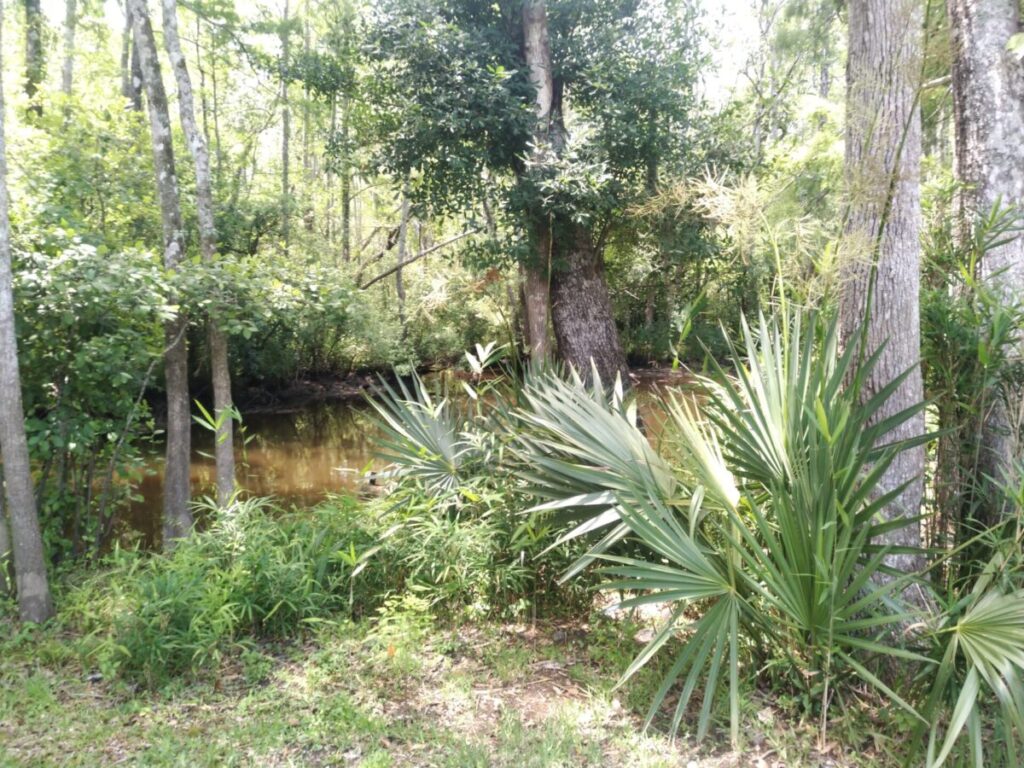By Matt Shortway
Photos courtesy Matt Shortway
There are many visitors to the beautiful saltwater beaches of eastern North Carolina all year round, but have you ever stopped just before the waves to visit the tidal marshes, brackish creeks, and tidal rivers? The intertidal zone is extremely rich in biodiversity that includes the area between low and high tide. Most people are aware of the tides along our beautiful coast; however, the tides continue to flow several miles inland through estuaries, creeks, and rivers.
It was while I was stationed at Marine Corps Air Station Cherry Point that my family and I began to explore these beautiful waters and headwaters in the Croatan National Forest. Throughout my Marine Corps career, my wife, three children, and I had the opportunity to explore the wonder the natural resources our country has to offer. From coast to coast our country is filled with unique ecosystems on display in national parks and forests that highlight each region’s ecosystem.
We Found an Undeveloped Tidal River
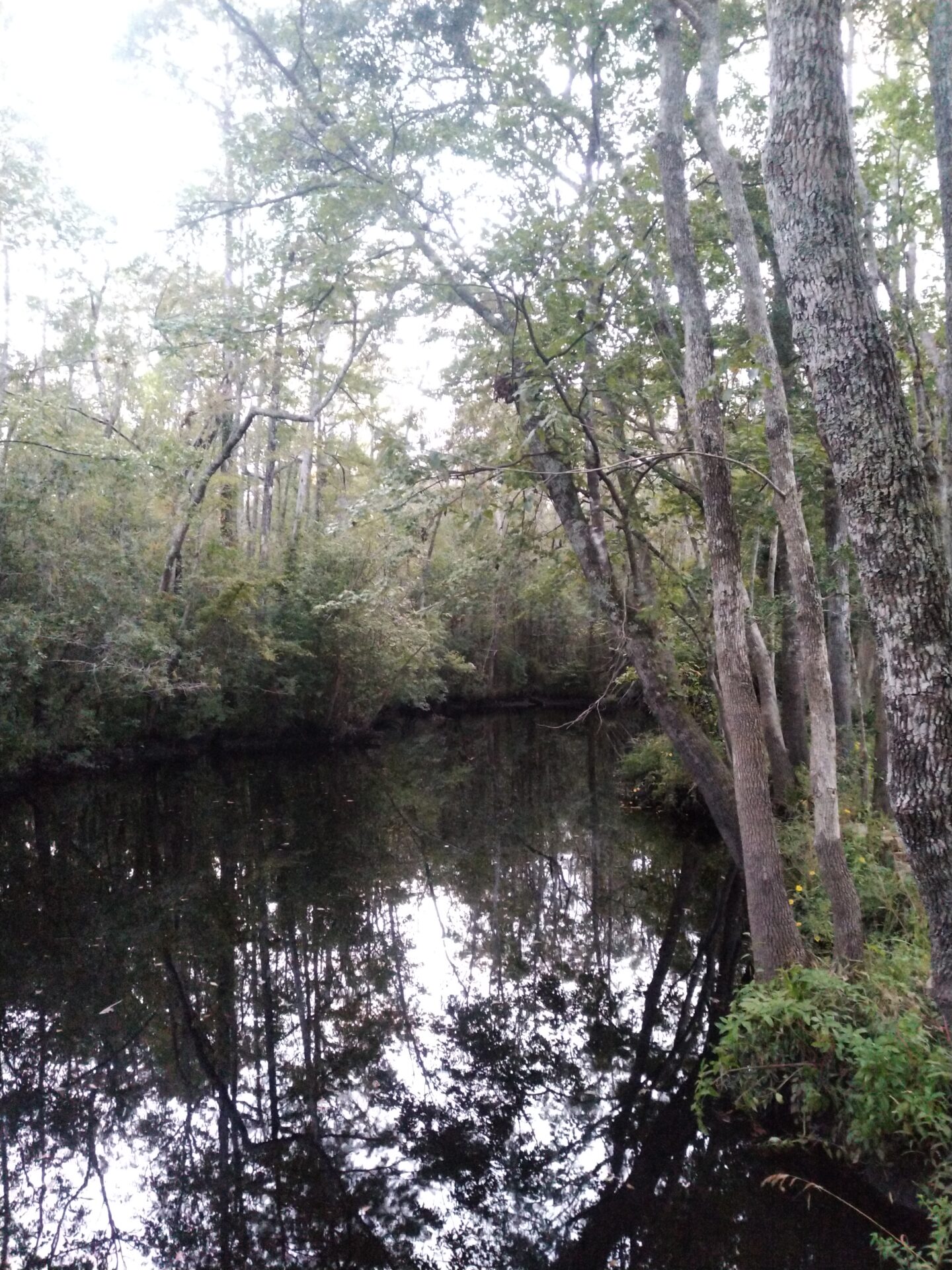
The Croatan National Forest has a few boat ramps and trails and it was on the NC Wildlife Newport River boat ramp that we truly began to appreciate native plants and wildlife. My son and I went from the center of Newport towards the headwaters. Hidden behind the bustling beach crowds and under the highway bridges is a mostly undeveloped tidal river meandering through a heavily forested tidal swamp. What we paddled through was an incredible journey that led us to peace and serenity together.
With an Amazing Ecosystem
About a country mile upriver is a small neighborhood that emerges from under bending trees and land covered in Royal Fern (Osmundia regalis), Cardinal Flower (Lobelia cardinalis), Dwarf Palmetto (Sabal minor), and a plethora of other native plant species. A home came on the market that the entire family fell in love with, so we made an offer with the hopes of living “inside” this amazing ecosystem.
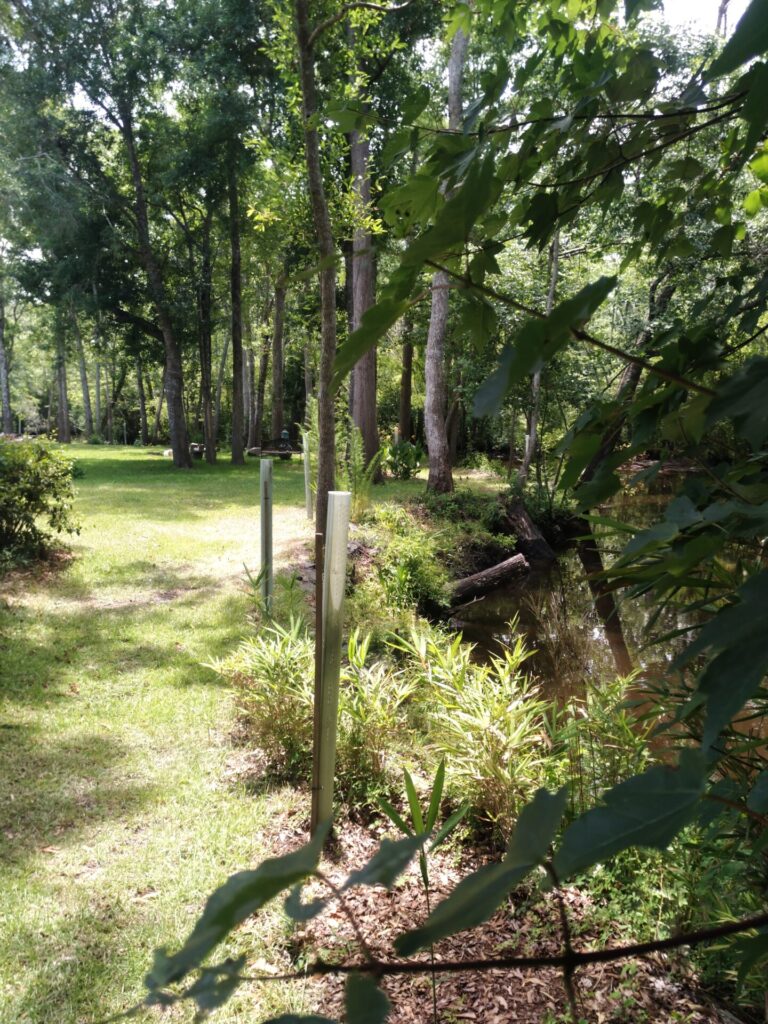
The previous owners and neighbors had made comments about flooding and erosion, so we set out with a plan to bioengineer the riverbank. The rough first draft was to protect the twenty feet of riverbank filled with strong root systems of native plants and begin to remove the non-native trees and shrubs at the homesite. As we continued kayaking, we noticed that several meanders pivot on enormous and upright Bald Cypress (Taxodium distichum) while the understory was covered in Dwarf Palmetto (Sabal minor). This differed from the common view of Sweet Gum (Liquidambar styraciflua), Longleaf Pine (Pinus palustris), and various oaks that leaned stretching for sunlight. These pioneer species fall across the river, tearing mounds of dirt, while the Bbald Cypress hugged the ground around it with its protruding knees surrounded by various obligate (OBL) wetland species.
The property contained five mature Bald Cypress, two mature Dwarf Palmetto patches and a few small groups of River Cane (Arundinaria gigantea). At the base of the Dwarf Palmettos were hundreds of volunteers. Step one was to relocate about forty of the volunteers spaced ten feet across the 600’ bank, with the cold-hardy, understory palm trees that form an interesting underground trunk and saxophone root system. River Cane, with its fibrous root system that can form large colonies spreading by rhizome, would slow surface erosion. Bald Cypress was then planted every 20’ along the edges with the intention to help support the soil with a deep, wide-spreading root system.
Some Native Plants are Aggressive, Some are Desirable
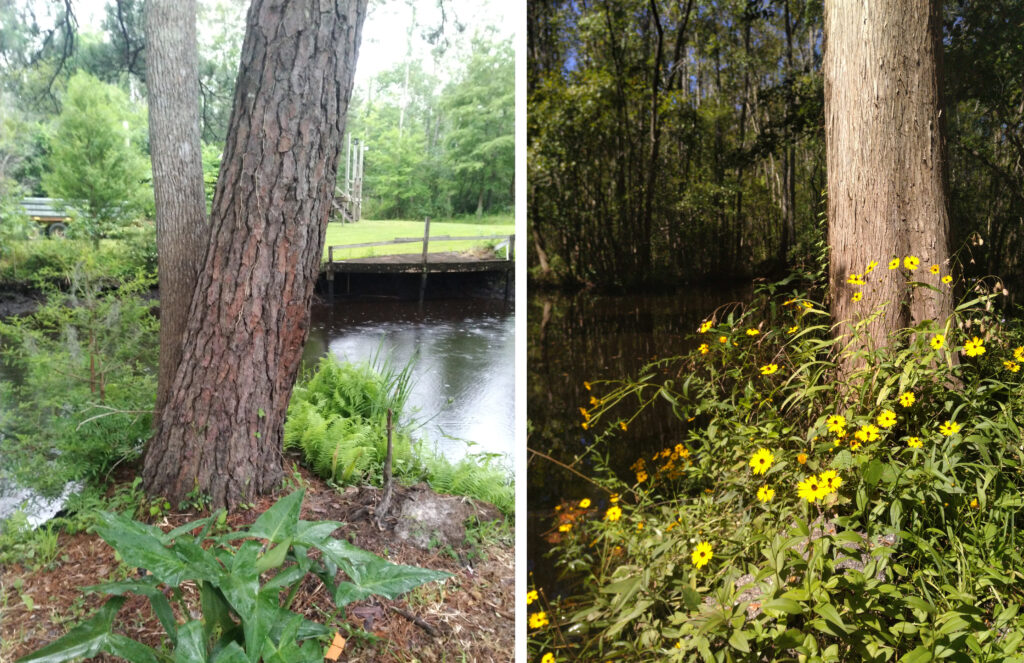
Growing throughout the riverbank were several brier species, Eastern Poison Ivy (Taxicodendron radicans) and Trumpet Creeper (Campsis radicans). These native species had become extremely aggressive, climbing over, around, and up almost everything in the area. The next spring, Royal Fern, Southern Lady Fern (Athyrium asplenioides), and Southern Blue Flag (Iris virginica) became visual. By summer Cardinal Flower, Common Stargrass (Hypoxis hirsuta), Juncus sp., Eastern Rose-mallow (Hibiscus moscheutos), Swamp Rose (Rosa palustris) and Arrow Arum (Peltandra virginica) gained our attention. In the fall the banks are filled with yellow Swamp Coreopsis (Coreopsis gladiata). The light bulb went off inside our heads!
Removing Aggressives allowed Natives to Flourish
Surrounded on the riverbanks are species hugging on in the intertidal zone providing color and features often highlighted in our country’s national parks and forests. How many species did we quickly paddle by and not notice? How could we preserve this ecosystem and ensure its species an everlasting habitat?
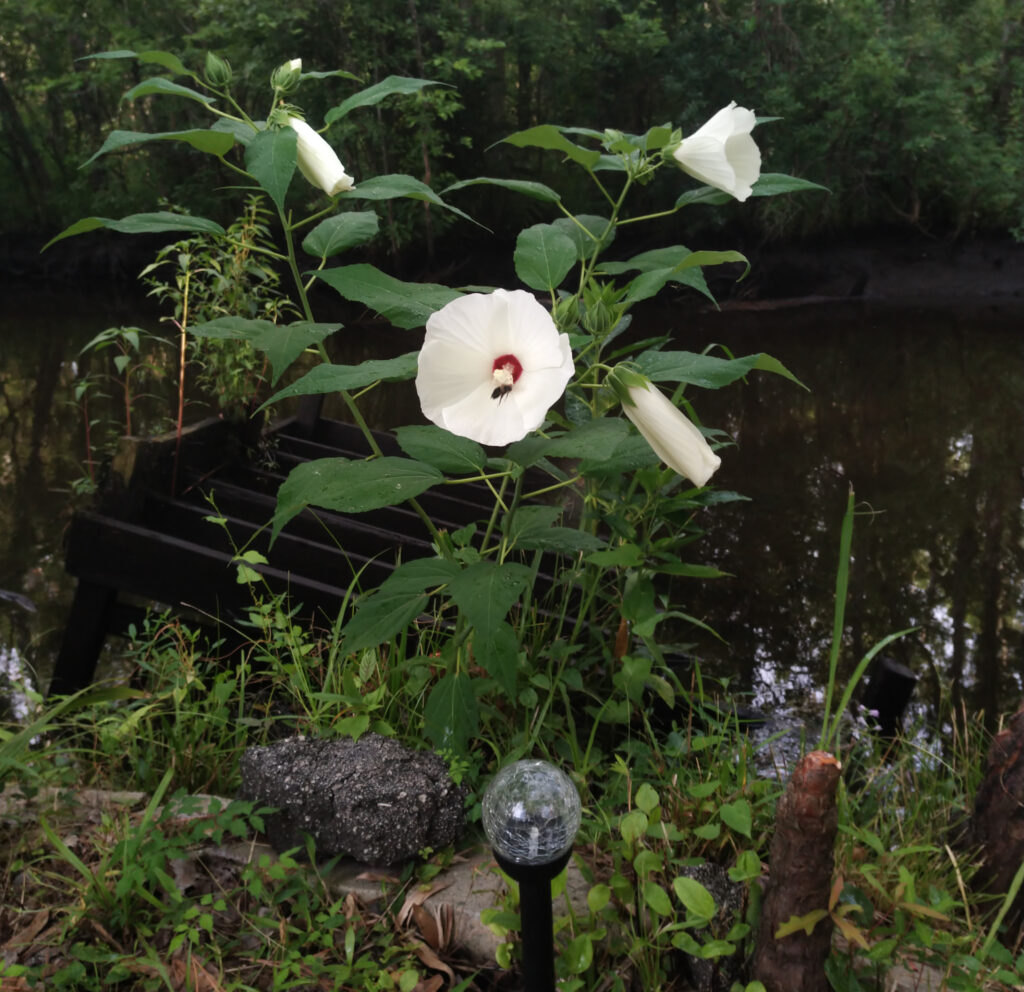
That first year after cutting back some aggressive species, to our amazement, there was so much more present and growing along the banks. Most of our natives start small and may not flower the first year, such as Eastern Rose-mallow. Only identifiable by its leaves in the first year, the hibiscus pictured provided blossoms this year and several more specimens have been identified. These blooms will only last a day, but open to six inches wide and new flowers bloom daily for a full month.
The Cardinal Flower was eye-catching with its tall slender stalks illuminated in some of the deepest red blooms nature can provide. It’s a short-lived perennial that provides amazing contrast nestled between ferns, grasses, and shorter species. The four that arrived that first year produced hundreds of thousands of miniscule seeds, but they easily germinate in the right conditions. We attempted several ways to encourage this bright red hummingbird magnet.This past summer we had about forty Cardinal Flowers in the tidal zone and a few further in.
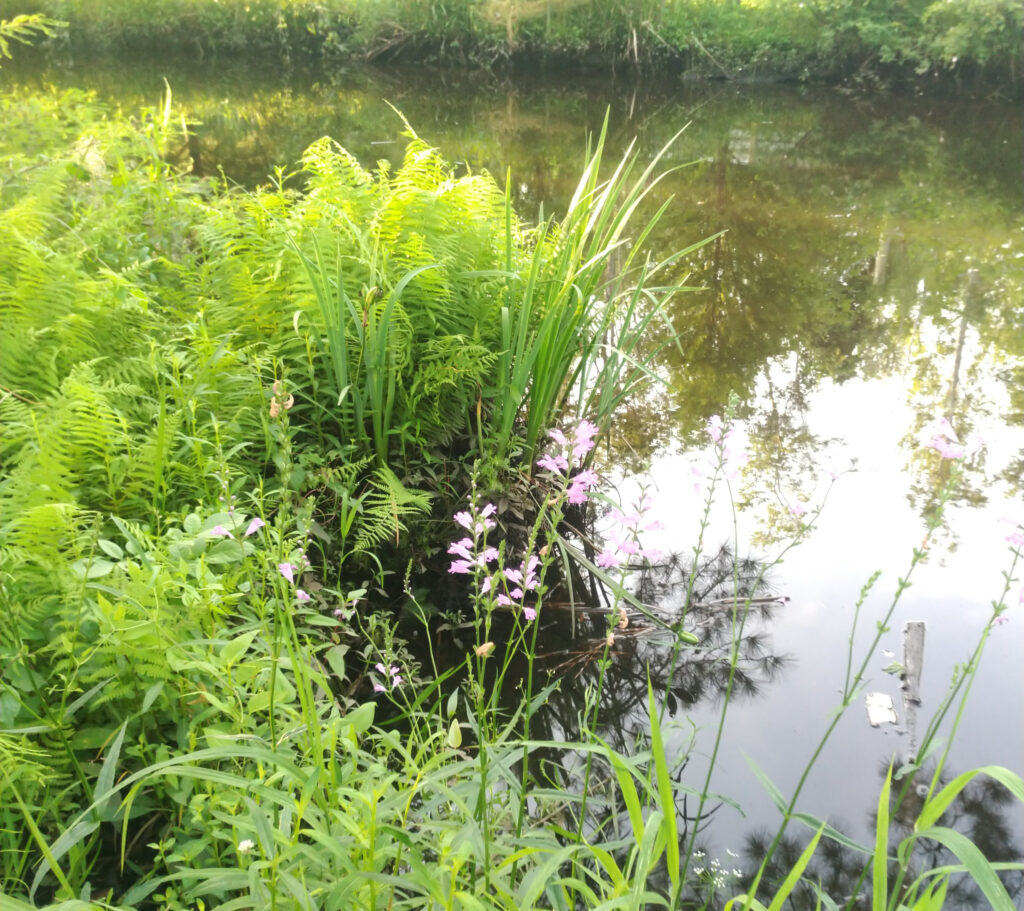
This spring a prolific species leaped up higher than most species, the Obedient-plant (Physostegia virginiana). The rhizomes or seeds must have lain dormant for some time and now could be found throughout the area. Similar looking to Cardinal Flower, it extended above the ferns and grasses on slender stalks that bloomed an appealing pink/purple. As the month went on, these stalks continued to bloom upwards and made a long-lasting cut flower inside the home.
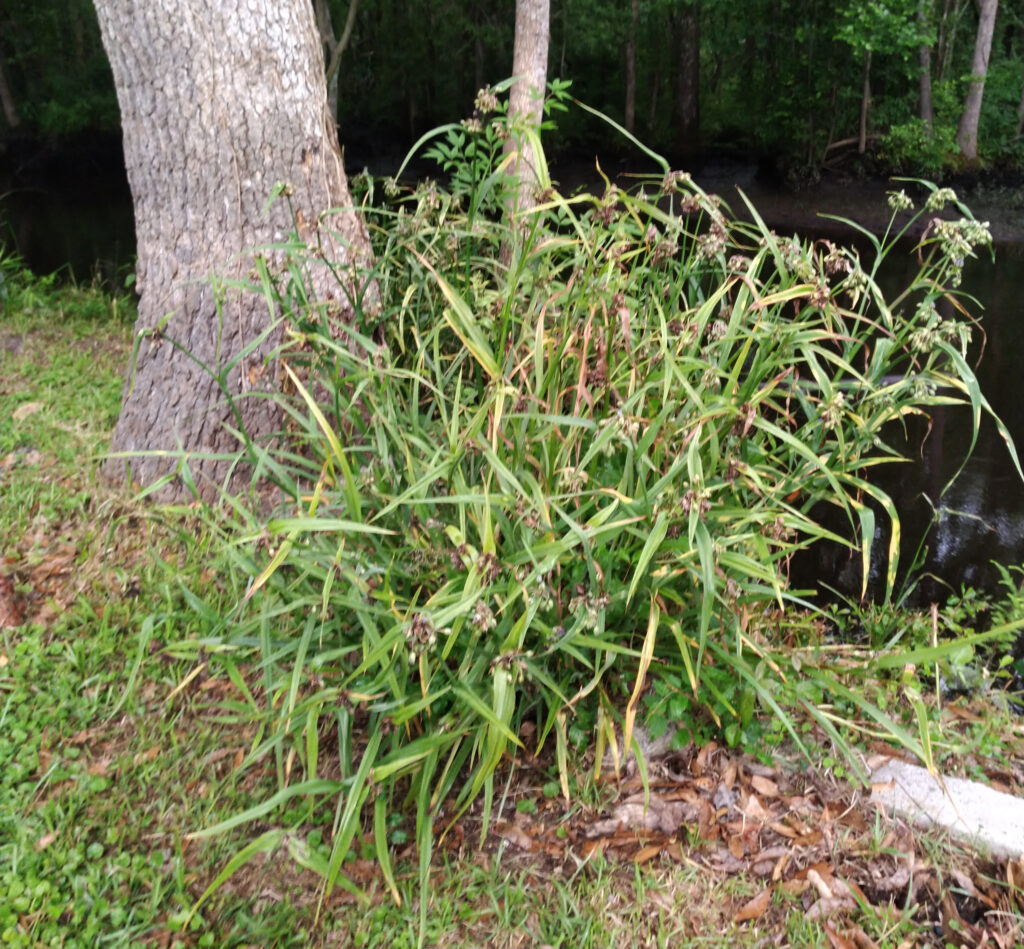
Virginia Spiderwort (Tradescantia virginiana) is in bloom at the same time as the Obedient-plant and can form dense clumps, which are easily transplanted. The sedge-like leaves form mounds with rounded stalks topped with multiple blue or purple flowers. The flowers of this species only bloom for a single day, but are readily replaced because each stalk may contain about twenty flowers. This species can be aggressive since it spreads through rhizomes and seeds, so before the seed matures and the leaves fade we give them a trim back to about 6’ tall and wait for another blooming period in the fall.
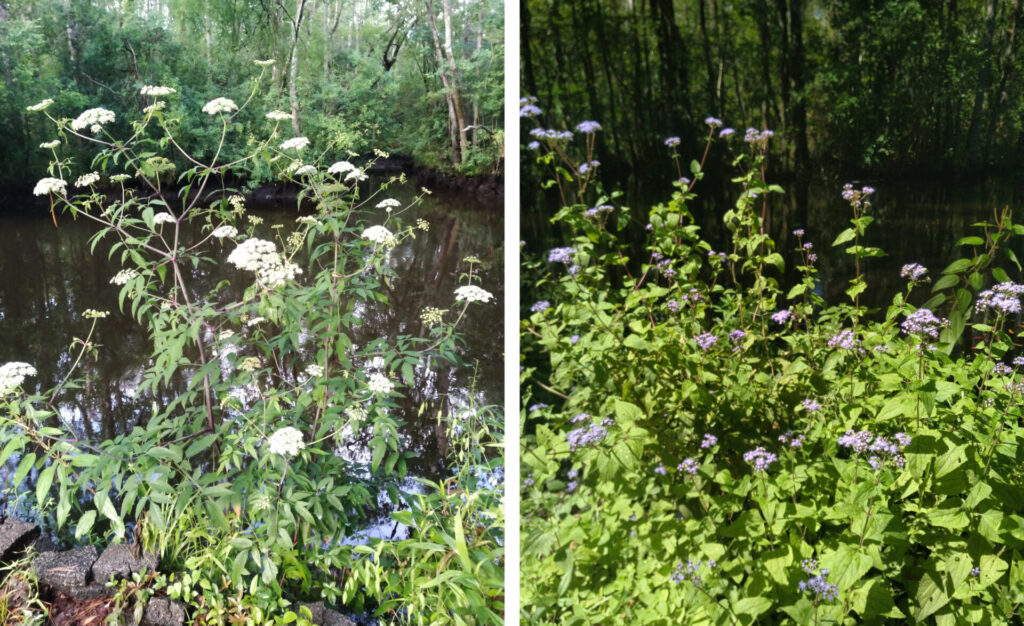
Some of our natives have evolved to be poisonous, but fortunately for us, we can keep them for aesthetic beauty and separate them from our vegetable gardens. One such plant is Spotted Water-hemlock (Cicuta maculata) that grew to over 6’ tall with a similar spread. A wonderfully colored species was Blue Mistflower (Conoclinum coelestinum). There was a single eight-inch-tall plant covered with purple-bluish flowers that we encouraged so we could get a better look next year. It has now grown to a bush shape and appears in a few more locations. The purple scattered among a sea of yellow fall blooms from Swamp Coreopsis are making a wonderful addition to the yard.
Joining the NCNPS Made a Difference
After joining the NCNPS, I met with other members, described my situation, and invited them to help us identify flora in the yard. Our new friends headed straight for the kayak drop, a place where reed mats carry seed and already germinated OBL wetland species can get stuck. Carol Peoples and Anna Meadows Helvie’s expertise in both natives and non-natives came to light as they began to point out many overlooked species in their few moments at that location alone.
There was a small, six-inch herbaceous flower with seed pods beginning to form that I had completely overlooked. My new friends identified it as a Coastal Rose-pink (Sabatia calycina). As we walked the banks, we discovered it and Marsh Eryngo (Eryngium aquaticum), the less common aquatic variation of Rattlesnake-master.
I realized that the aggressive Trumpet Creeper has great value, along with the Whiteleaf Greenbriar (Smilax glauca) and an interesting Arrowleaf Tearthumb (Persicaria sagittate). The Arrowleaf Tearthumb appeared mingled in River Cane and has such interesting shaped leaves that I left some mingling in other locations. This summer there’s at least five specimens. As fall approached, it began producing small pink flowers. A great addition to texture and shape in the habitat, and not so aggressive.
Our intentions of utilizing the natural root structure of the Bald Cypress also have led to better appreciation of trees already on the property. Most of us are familiar with the larger species of oaks and pines, but the understory displays another depth that many, including myself, are unfortunately quick to remove.

One such species is Ironwood/American Hornbeam (Carpinus caroliniana) with some of the most interesting bark we’ve ever seen. It’s slow growing to 20-30’ with a branching, smooth, and bumpy truck. Ironwood bark takes a muscle-like appearance and its sawtooth leaves turn a brilliant orange as the weather cools.
Our Dream Continues to Evolve
We are only three summers into our dream of living among the beauty of the Newport River and Croatan National Forest and our vision of slowing erosion has developed into so much more. The native habitat is so much more than that – it is a place for our children to study and play in the environment. We live surrounded by Great Horned Owls, red falcons, Red-cockaded Woodpeckers, beavers, otters, reptiles, insects, birds, fish, and many other fauna that utilize native plants for food, shelter and for play too!
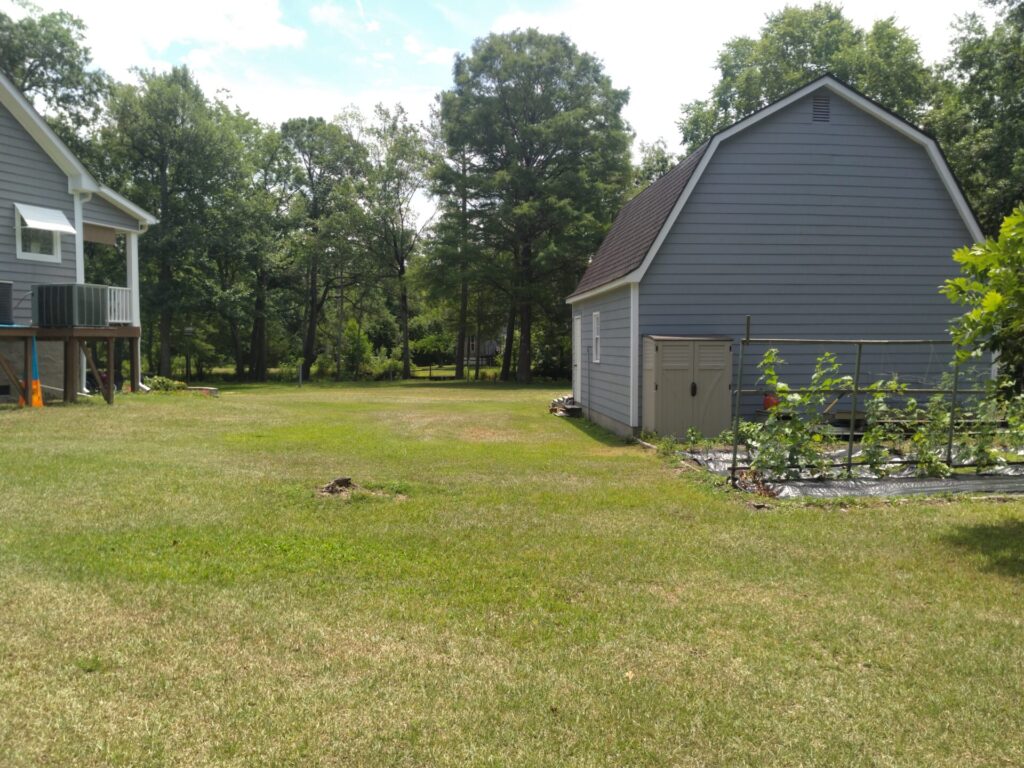
To Protect our Native Habitat We Envision and Plan
My family and I do not know how our vision for our native habitat will continue to develop. It teaches us more than we know while providing low-maintenance beauty throughout our days. In the short time we’ve been encouraging and caring for these few native species, conservation of the environment has come to the forefront of my mind. The one-thousand-year-old Bald Cypress in our coastal communities have witnessed the changing phases of the habitat, and our lives are but a blink of an eye to these enormous giants, but they will prevail with the combined efforts of NCNPS members.
Coming Together as a Community
Many members of our community are unaware of the native beauty that we live in, often going for the nursery plants of mass propagated azalea, camellia, mums, and Bradford Pear, to name a few.We’ve gotten at least a few friends and family now noticing how important the flora of our area is to wildlife and the intrinsic beauty they provide. Coming together as a community we can bring about a revolution to utilize the species that are hardy, gorgeous and readily available after a few millennia of adaptation. We all just need a little education and patience to watch it sleep, creep and leap!
By Matt Shortway
Photos courtesy Matt Shortway
Native Plant News – Winter 2022

Matt Shortway is a member of the Coastal Plain Chapter, NC Native Plant Society and a self-professed science geek. After ten years of service across the country with the Marine Corps, his family decided to settle in eastern North Carolina where they utilize state-grown grains to create beverages at the Shortway Brewing Company.
